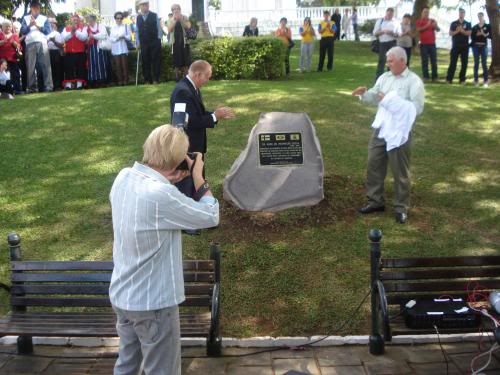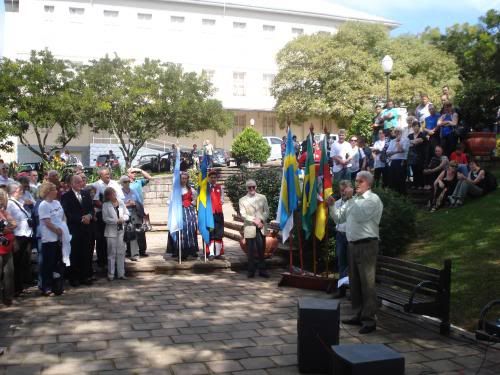n 1768, the scientist Daniel Solander, disciple of Carl von Linné, was the first known Swede to arrive in Brazil.
The relations between Brazil and Sweden were rooted in the family ties between the Brazilian and Swedish Royal Families, and in the Swedish emigration to Brazil at the end of the 19th century. King Oscar I's wife, Queen Josefina av Leuchtenberg, was sister to Amelia de Leuchtenberg, wife of Emperor Pedro I. Diplomatic relations between Brazil and Sweden were established in 1826.
In Riddarholmen, where Swedish kings and noblemen are buried, there are commemorative plaques of Emperors Pedro I and Pedro II as well as of President Epitácio Pessoa (who received the Order of Serafim). The first Swedish emigrants arrived in Brazil in 1890, and in 1909 the first sea line between the two countries was initiated.
In Curitiba, one of the first Scandinavian of note to arrive was Alfredo Andersen, an artist who arrived towards the end of the 19th century and painted well into the 1930s. The Museu Alfredo Andersen contains much of his work, located in Paraná (state).[4] In addition, Icelandic immigrants settled there in 1863 and again in 1873.
Probably the largest concentration of Swedish immigrants in Brazil is located in the area of Missões in the southern state of Rio Grande do Sul, where in the late 1800s 200 Swedish families moved to the city of Guarani das Missões.
Examples of this immigration is the Karlson House (Casa Sueca) in Guarani das Missões, the Svenska Kulturhuset in the district of Linha Jansen (Farroupilha, RS), the Mission of Örebro in Venancio Aires, RS. Swedish cultural groups include the Ovenska Danser ballet of Ijuí, RS and the Ballet Patrícia Johnson of Bento Gonçalves, RS.
In April 2010, the City of Nova Roma, RS celebrated the 120th anniversary of the Swedish immigration to the city. Earlier, in 1991, the city of Ijui, RS celebrated the immigration of the Swedes to their city with the opening of a Swedish Cultural Center in the city.
There was also significant immigration of Swedish citizens to the city of São João da Boa Vista, in the state of São Paulo. Here's some pictures.![]()
![]()
![]()
The relations between Brazil and Sweden were rooted in the family ties between the Brazilian and Swedish Royal Families, and in the Swedish emigration to Brazil at the end of the 19th century. King Oscar I's wife, Queen Josefina av Leuchtenberg, was sister to Amelia de Leuchtenberg, wife of Emperor Pedro I. Diplomatic relations between Brazil and Sweden were established in 1826.
In Riddarholmen, where Swedish kings and noblemen are buried, there are commemorative plaques of Emperors Pedro I and Pedro II as well as of President Epitácio Pessoa (who received the Order of Serafim). The first Swedish emigrants arrived in Brazil in 1890, and in 1909 the first sea line between the two countries was initiated.
In Curitiba, one of the first Scandinavian of note to arrive was Alfredo Andersen, an artist who arrived towards the end of the 19th century and painted well into the 1930s. The Museu Alfredo Andersen contains much of his work, located in Paraná (state).[4] In addition, Icelandic immigrants settled there in 1863 and again in 1873.
Probably the largest concentration of Swedish immigrants in Brazil is located in the area of Missões in the southern state of Rio Grande do Sul, where in the late 1800s 200 Swedish families moved to the city of Guarani das Missões.
Examples of this immigration is the Karlson House (Casa Sueca) in Guarani das Missões, the Svenska Kulturhuset in the district of Linha Jansen (Farroupilha, RS), the Mission of Örebro in Venancio Aires, RS. Swedish cultural groups include the Ovenska Danser ballet of Ijuí, RS and the Ballet Patrícia Johnson of Bento Gonçalves, RS.
In April 2010, the City of Nova Roma, RS celebrated the 120th anniversary of the Swedish immigration to the city. Earlier, in 1991, the city of Ijui, RS celebrated the immigration of the Swedes to their city with the opening of a Swedish Cultural Center in the city.
There was also significant immigration of Swedish citizens to the city of São João da Boa Vista, in the state of São Paulo. Here's some pictures.


